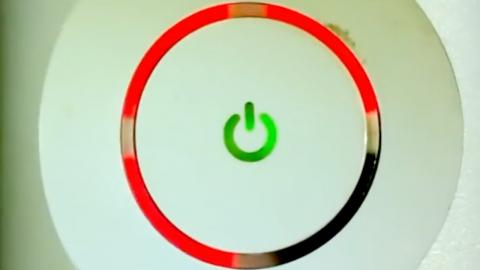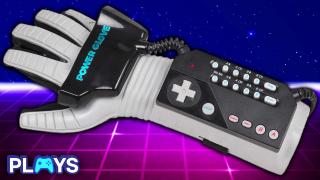Top 10 Notoriously Defective Pieces Of Video Game Hardware

There's no patch or online update that'll fix these problems. Welcome to WatchMojo.com, and today we'll be counting down the Top 10 Notoriously Defective Piece of Video Game Hardware.
Special thanks to our user “Dan Paradis” for suggesting this topic using our interactive suggestion tool at http://WatchMojo.comsuggest
#10: Roll n Rocker
10 Times Resident Evil Made Us Roll Our Eyes
No, not Rock N Roller, that would have been too clever. This contraption was meant to be used instead of the NES controller's D-Pad. You'd stand on it and rock back and forth to move. While touted to be compatible with every NES game, it barely worked with any, especially if you weighed over 100lbs. You still had to use the controller to press the B and A buttons, so what why would you not just use the D-Pad, instead of struggling with this unwieldy piece of plastic? Even if it worked, the Roll N Rocker was pretty much useless..
#9: R.O.B. the Robot
Top 20 Worst Video Game Consoles
You might know this cute but deadly Robotic Operating Buddy from Super Smash Bros, but ROB was actually bundled with the original release of the NES back in 1985. If you were expecting a rad futuristic experience though, you were sorely mistaken. He used flashes from the CRT-TV to know when to move, and would press the B or A buttons on controller 2, and stack up colored cylinders. The main problem was, ROB was horrendously sloooow, so it was much easier to just press the buttons yourself. Add this to the fact that there were only 2 games made to use ROB, and we have yet another NES accessory we can do without.
#8: Voice Recognition Unit aka VRU
Top 10 Video Game Voice Actor Performances
Ah, the 90s and voice recognition... You can guess how this turned out. Nintendo's Voice Recognition Unit, known as a VRU, was a peripheral for the N64. It was supposed to allow players to talk and give simple voice commands in certain games. It was only compatible with 2 games though, Hey You Pikachu!, and... this train conductor simulator? Anyway, that's not even the worst part. The VRU was made specifically for a younger audience with higher pitched voices. That meant anyone past puberty would have trouble getting the darned thing to work properly. Thankfully, no other games required it, and Nintendo semi-redeemed themselves years later with the Wii Speak.
#7: The Power Glove
The Worst Video Game Controller of All Time
Ok, if you want to look like a Jedi master, telekinetically moving objects on the screen with your arm outstretched, the Power Glove's definitely for you. While wearing it, and after setting up the sensors around your TV, you could control the game using fist clenching, finger wagging, or hand waving. Well in theory anyway. Despite an awesome design and concept, motion sensors in the late 80s just weren't efficient, leading to trouble controlling nearly every game. “The Wizard” made it look easy, but the glorified ad kept the truth hidden well enough to sell the accessory. It wasn't enough though, and thankfully the Power Glove was discontinued less than a year later.
#6: Atari Mindlink
Top 10 Atari FAILS
If you thought having a robotic friend in the 80s was too ambitious for its time, you ain't seen nothin' yet. The Atari Mindlink was meant to be a hands-free controller, reading the myoneural signal voltage from your forehead. Sounds high-tech, but you basically just place it on your head and move your eyebrows around. Only 3 games were made for use with it, Bionic Breakthrough, Telepathy, and Mind Maze, but none were released. Why? Well the Mindlink itself never got released. Testers got frequent headaches from moving their foreheads so much, and down it went with the rest of the video game industry during the crash in the mid-80s.
#5: Sega Activator
The Greatest SEGA Game of All Time
The polar opposite of the Mindlink, the Sega Activator, released in 1993, has you punching and jump kicking to your hearts' content. After putting the plastic octagon together, you just step inside it and infrared sensors detect which move you want to do. The problem was that if you have any kind of ceiling decoration, like lights or a fan, the sensors wouldn't work properly. Even if the setup was perfect, it'd be inaccurate, leaving you leaping and roundhouse kicking resulting in completely different moves on screen. Factor in its immense price tag at the time, and you might want to deactivate your interest in the Activator.
#4: Atari 5200 Controller
Superman 64 VS E.T. Atari: Battle for the Worst Game Ever
In comparison to the other control devices on this list, the Atari 5200 controller wasn't as innovative, but it still managed to fail. Not only that, it's thought to be the main cause of the 5200's commercial downfall. It was supposed to be an upgrade to the Atari 2600 controller, offering 360 degree analog control instead of the regular 8-direction control. It came with a number pad also, and the now essential Pause button, which was new at the time. Unfortunately, the joystick wasn't self-centering, using rubber centering instead of springs, and the firing buttons were too soft. This led to 9 different controller revisions and 3rd-party developments, but it was discontinued as Atari focused on the 7800.
#3: Konami LaserScope
Top 10 Unbelievable Konami Fails
The LaserScope was meant to be an alternative to the boring old NES Zapper. Just put on the headset, and yell “FIRE!” to shoot on the screen. It was supposed to be the quieter, as the game audio came through the headphones, but ironically, having to yell every time you wanted to shoot made it much worse. Some of these games needed you to be shooting constantly. Add that to the fact that, any noise the mic picked up caused it to fire, even background noise, and the device became ineffective. As a plus though, the headphones were advertised to be compatible with Walkmans, but God help you if you decided to wear these in public... even in the 90s.
#2: Xbox 360
Top 10 Video Game Franchises Xbox Now Owns
Just when you thought you were free of the maddening Blue Screen of Death, Microsoft came out with its sequel, the Red Rings of Death. Seeing the 3 rings appear on your Xbox 360 was always heart-dropping. It indicated a “general hardware failure”, and led to freezes, and graphical and sound errors. Failure rates for the console were reported as high as 33% according to retailers, with a repair shop in the UK reportedly receiving 2500 defective consoles daily! In a watershed moment, management decided to pay for the shipping and repairs of the faulty Xbox 360s. The high cost of $1.15B was a blow, but the move is thought to have saved the Xbox franchise.
#1: Amstrad GX4000
Amstrad's jump into the console market didn't go as planned with this upgrade of their 8-bit CPC. Released in 1990, it was much too late to the party, as the 16-bit era was just around the corner. But the kicker was its cheap power supply unit. For whatever reason, you had to plug the wire into your console before plugging it in the wall. Unplugging it from the console first, or plugging into the wall first risked either frying your unit, or exploding. Yes you heard right, you console’s power supply could explode. There were warning labels on the PSU to alert users, but eventually the wires weren't recommended for use at all. It’s a good thing this system failed at retail.










